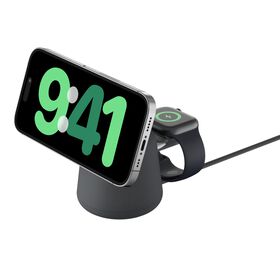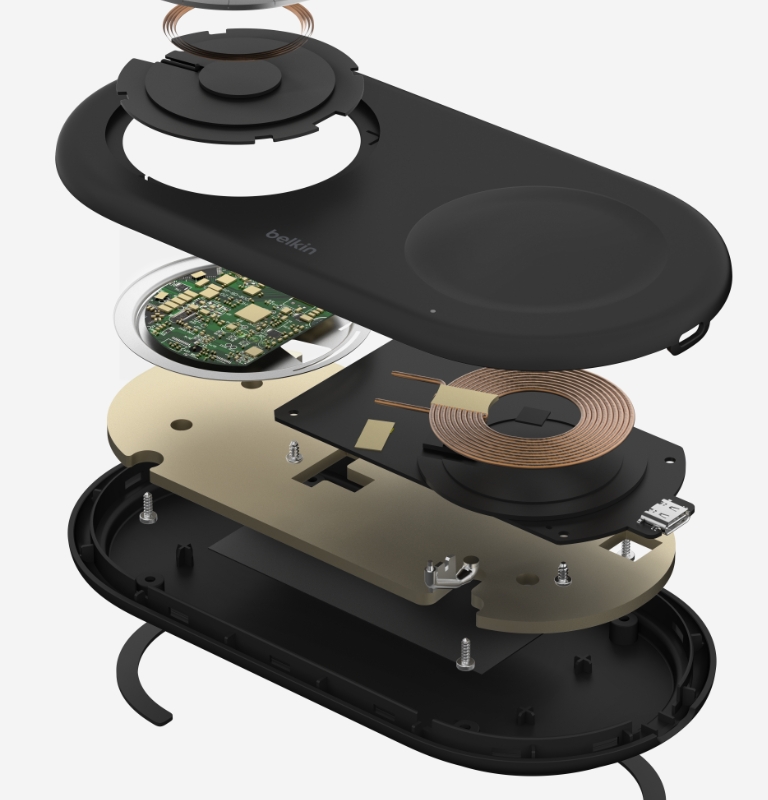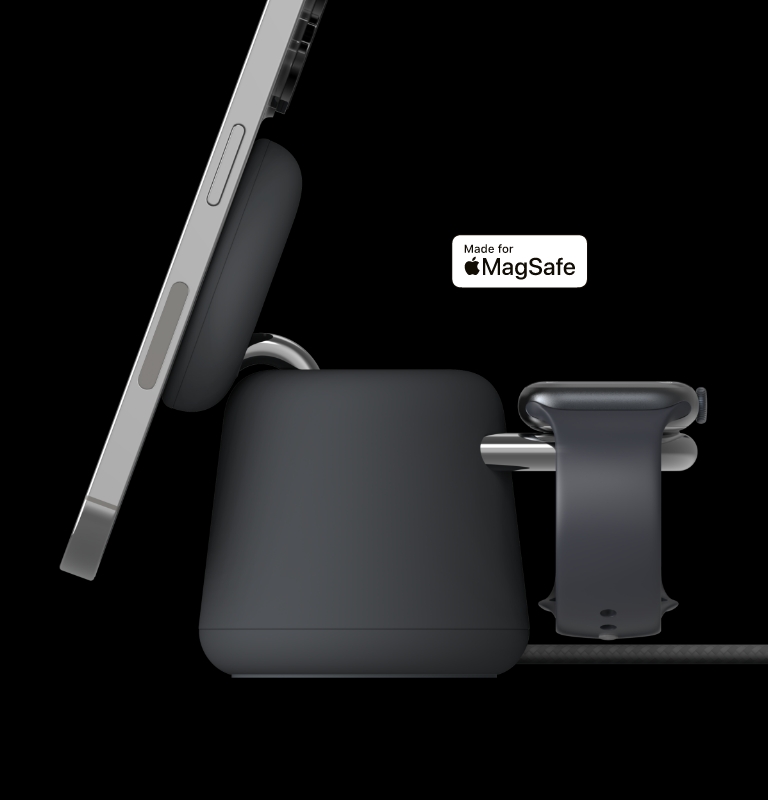Mehr zu kabellosen Ladegeräten erfahren.
Häufig gestellte Fragen zu kabellosen Ladegeräten
Kabellose Handy-Ladegeräte bieten Ihnen die Möglichkeit, Ihr Handy zu laden, ohne es mit einem Kabel anzuschließen. Sie brauchen Ihr Gerät nur auf einem Ladepad oder Ladeständer zu platzieren. Dann wird es automatisch mithilfe eines elektromagnetischen Feldes aufgeladen. Der Ladevorgang ist sicher, da er über einen Chip gesteuert wird, der eine Beschädigung Ihres Geräts verhindert Erfahren Sie hier wie das funktioniert.
Weder der magnetische Ladevorgang noch kabellose Ladegeräte schaden Akkus. Die Akkukapazität lässt jedoch im Laufe der Zeit durch Laden und Entladen nach. Kontinuierliches Laden kann Akkus von Geräten schaden. Er wird empfohlen, Geräte vom Ladegerät zu entfernen, wenn sie vollständig aufgeladen sind. Hier erfahren Sie mehr zur Sicherheit.
Apple-Geräte: iPhone 8 und höher
Samsung-Geräte: Galaxy Note-Telefone: Galaxy Note20 5G, Note20 Ultra 5G, Note10+, Note10, Note9, Note8 und Note5; Galaxy S-Handys: S23-Serie, S22-Serie, S21-Serie, S20-Serie, S10-Serie, S9-Serie, S8-Serie, S7-Serie und S6-Serie; faltbare Handys: Galaxy Z Fold, Z Fold2, Z Fold3, Z Fold4, Z Flip, Z Flip 5G, Z Flip3 und Z Flip4
Google Pixel-Geräte: Pixel 3, Pixel 3 XL, Pixel 4, Pixel 4 XL, Pixel 5, Pixel 6, Pixel 6 Pro, Pixel 7, Pixel 7 Pro
Um ein kabelloses Ladepad zu verwenden, müssen Sie es zunächst an eine Stromquelle anschließen und Ihr Gerät darauf platzieren. Achten Sie dabei darauf, dass es zentriert ausgerichtet ist und folgen Sie eventuellen Anweisungen. Warten Sie, bis der Ladevorgang beginnt. Möglicherweise sehen Sie dies an einer Anzeige, etwa einer LED. Es ist wichtig zu wissen, dass nicht alle Geräte mit allen kabellosen Ladegeräten kompatibel sind. Überprüfen Sie also Ihre Gerätespezifikationen, um Kompatibilität mit dem Ladestandard sicherzustellen.
Kabellose Ladepads verwenden eine induktive Ladetechnik, die Energie kabellos vom Ladegerät auf das Gerät überträgt, das geladen wird. Hierzu werden zwei Spulen verwendet, die ein magnetisches Feld erzeugen. Eine befindet sich im Ladegerät und die andere im Gerät. Sie meisten kabellosen Ladegeräte verwenden MagSafe-, Qi- oder Qi2-Module. Kompatibilität, Ladegeschwindigkeiten und andere Funktionen können sich abhängig von der jeweils verwendeten kabellosen Ladetechnologie voneinander unterscheiden.
Kabellose Ladeständer sind ähnlich wie Ladepads, bringen das Gerät aber in eine Position, die auch während des Ladens die Ansicht des Bildschirms ermöglicht. Sie verwenden eine induktive Ladetechnik, die Energie kabellos vom Ladegerät auf das Gerät überträgt, das geladen wird. Das Ladegerät enthält eine Drahtspule, die ein elektromagnetisches Feld erzeugt. Das Gerät, das geladen wird, enthält eine Spule, die die Energie dieses Feldes zum Laden des Akkus aufnimmt. Die meisten Ladeständer verwenden den Standard Qi, der den Ladevorgang optimiert, indem er Leistung und Geschwindigkeit anpasst. Das Gerät kann während des Ladens auch zur Ansicht verwendet werden.
Die meisten modernen iPhones sind mit Funktionalität zum kabellosen Laden konzipiert. Hier eine Übersicht von iPhone Modellen mit der entsprechenden Funktion:
- iPhone 8 und höher: Alle Modelle ab iPhone 8 eignen sich zum kabellosen Laden.
- iPhone X und höher: Hierzu zählen iPhone X, XS, XS Max, XR und neuere Modelle.
- iPhone 11-Serie: Alle Modelle, einschließlich iPhone 11, 11 Pro und 11 Pro Max.
- iPhone 12-Serie: Alle Modelle, einschließlich iPhone 12, 12 mini, 12 Pro und 12 Pro Max. Diese Modelle eignen sich auch zum kabellosen Laden mit MagSafe.
- iPhone 13-Serie: Alle Modelle, einschließlich iPhone 13, 13 mini, 13 Pro und 13 Pro Max; diese Modelle eignen sich auch zum kabellosen Laden mit MagSafe.
- iPhone 14-Serie: Alle Modelle, einschließlich iPhone 14, 14 Plus, 14 Pro und 14 Pro Max; diese Modelle eignen sich auch zum kabellosen Laden mit MagSafe.
Ja, viele Handys von Samsung eignen sich zum kabellosen Laden. Hier ist eine Übersicht von Modellen von Samsung, die sich zum kabellosen Laden eignen:
- Galaxy S-Serie: Samsung Galaxy S6 und höher: Ab Galaxy S6 eignen sich alle Modelle einschließlich S6 Edge, S7, S7 Edge, S8, S8+, S9, S9+, S10e, S10, S10+, S20, S20+, S21, S21 Ultra, S22, S22+, S22 Ultra, S23, S23+ und S23 Ultra zum kabellosen Laden.
- Galaxy Note-Serie: Galaxy Note 5 und höher: Alle Modelle einschließlich Note 8, Note 9, Note 10, Note 10+, Note 20 und Note 20 Ultra eignen sich zum kabellosen Laden.
- Galaxy Z-Serie: Galaxy Z Fold- und Z Flip-Serie: Modelle wie Galaxy Z Fold 2, Z Fold 3, Z Fold 4, Z Flip, Z Flip 5 und Nachfolgemodelle eignen sich zum kabellosen Laden.
- Galaxy A-Serie: Bestimmte Modelle: Manche der Highend-Modelle und Geräte der Galaxy A-Serie wie Galaxy A80, A90 und A91 eignen sich zum kabellosen Laden, aber viele Modelle der Mittelklasse eignen sich nicht dazu.
- Galaxy M-Serie: Begrenzte Unterstützung: Die Modelle der preisgünstigeren Galaxy M-Serie eignen sich im Allgemeinen nicht zum kabellosen Laden.
Ja, viele Android-Handys eignen sich zum kabellosen Laden. Modelle der mittleren und höheren Preisklasse verfügen oft über diese Funktion. Hier ist eine Übersicht von Android-Handys, die sich zum kabellosen Laden eignen:
- Google Pixel-Serie: Pixel 3 und höher: Alle Pixel-Modelle ab Pixel 3 eignen sich zum kabellosen Laden: Pixel 3, Pixel 3 XL, Pixel 4, Pixel 4 XL, Pixel 5, Pixel 6, Pixel 6 Pro, Pixel 7 und Pixel 7 Pro.
- Samsung Galaxy Serie: Galaxy S-Serie: Ab Galaxy S6 eignen sich die meisten Modelle der S-Serie zum kabellosen Laden.
- Galaxy Note-Serie: Ab Note 5 und höher, einschließlich Note 20 Ultra.
- Galaxy Z-Serie: Einschließlich verschiedener Modelle der Serien Galaxy Z Fold und Z Flip.
- OnePlus: OnePlus 8 Pro und höher: OnePlus 8 Pro, OnePlus 9 Pro und OnePlus 10 Pro eignen sich zum kabellosen Laden. Dies gilt nicht für manche ältere Modelle.
- Xiaomi: Mi Mix 4 und höher: Mi Mix 4 und manche anderen Highend-Modelle wie Mi 11 und Mi 11 Ultra eignen sich zum kabellosen Laden.
- Sony: Xperia 1 und höher: Modelle wie Xperia 1 II, Xperia 1 III und neuere Xperia-Handys eignen sich zum kabellosen Laden.
- Oppo: Find X-Serie: Modelle wie Oppo Find X3 Pro eignen sich zum kabellosen Laden.
- Huawei: P40 Pro und höher: Huawei P40 Pro, Mate 40 Pro und ähnliche Highend-Modelle eignen sich zum kabellosen Laden.
- Andere Marken: LG: Manche Modelle wie LG V30, V35, V40 und G7 ThinQ eignen sich zum kabellosen Laden. LG ist jedoch aus dem Smartphone-Markt ausgestiegen. Asus: Bestimmte Modelle wie ROG Phone 5 eignen sich zum kabellosen Laden.
Beim Vergleich von kabellosen Ladegeräten für iPhones und Handys von Samsung müssen unterschiedliche Faktoren wie Kompatibilität, Leistung, Geschwindigkeit, Konstruktion und zusätzliche Funktionen berücksichtigt werden. Auf folgende Aspekte sollten Sie achten:
1. Kompatibilität
- iPhones: Qi-Standard und MagSafe (für iPhone 12 und höher). MagSafe sorgt für eine bessere Ausrichtung und liefert bis zu 15 W Leistung zum Laden.
- Samsung-Handys: Qi-Standard. Die meisten Modelle unterstützen eine Leistung von bis zu 10 W; manche sogar bis zu 15 W beim schnellen kabellosen Laden mit Ladegeräten von Samsung.
2. Ladegeschwindigkeit
- iPhones: Bis zu 7,5 W auf Standard-Qi-Ladegeräten. Bis zu 15 W mit MagSafe.
- Samsung-Handys: Bis zu 10 W auf Standard-Qi-Ladegeräten. Bis zu 15 W mit schnellen kabellosen Ladegeräten von Samsung.
3. Konstruktion und Funktionen
- iPhone-MagSafe-Ladegeräte: Magnetische Ausrichtung, stylische Ausführung, Integration mit MagSafe-Zubehör.
- Kabellose Ladegeräte von Samsung: Unterschiedliche Ausführungen (Pads und Ständer), manche mit zusätzlichen Funktionen wie Lüftern und der Möglichkeit mehrere Geräte aufzuladen.
4. Preis
- MagSafe-Ladegeräte: Im Allgemeinen höhere Preisklasse, da firmeneigene Technologie verwendet wird.
- Kabellose Ladegeräte von Samsung: Unterschiedliche Preisklassen; häufig günstig mit erhältlichen Zusatzfunktionen.
Die Ladegeschwindigkeit kabelloser Ladegeräte ist abhängig von der Leistung (W), vom betreffenden Netzteil und dem Gerät, das aufgeladen wird. Allgemeiner Überblick:
1. Normales kabelloses Laden
- iPhones: Bis zu 7,5 W bei der Verwendung von Qi-kompatiblen Ladegeräten.
- Samsung-Handys: Normalerweise bis zu 10 W bei der Verwendung von Qi-kompatiblen Ladegeräten. Manche Modelle unterstützen jedoch eine höhere Leistung.
2. Schnelles kabelloses Laden
- iPhones: Bis zu 15 W mit Apples MagSafe-Ladegeräten für iPhone 12 und höher.
- Samsung-Handys: Bis zu 15 W mit kabellosen Ladegeräten von Samsung selbst, etwa solchen für Galaxy S21 Ultra oder Note 20 Ultra.
Zusammenfassung zur Leistung (je höher die Leistung desto schneller das Laden)
- iPhone Standard: 7,5 W
- iPhone MagSafe: Bis zu 15 W
- Samsung Standard: Bis zu 10 W
- Samsung mit Schnelladefunktion: Bis zu 15 W
Hinweis: Die tatsächliche Ladegeschwindigkeit wird von Faktoren wie der Stärke der Handyhülle, der Ausrichtung auf dem Ladegerät und der Ausgangsleistung des Ladegeräts beeinflusst. Mehr zum schnellen kabellosen Laden erfahren.

_MPP242_MagneticWirelessPowerBank5K+Stand_FPK_WH_Shot1_Web.jpg?sw=280&sh=280&sm=fit&sfrm=png)














